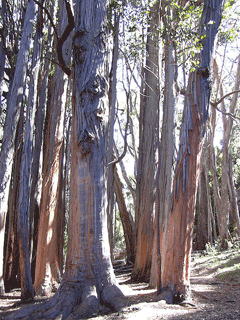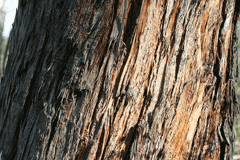 |
|
http://www.hear.org/starr/ |
 |
| http://www.flickr.com/people/32005048@N06 |
Translate this page:
Summary
Physical Characteristics

 Eucalyptus obliqua is an evergreen Tree growing to 60 m (196ft 10in) at a fast rate.
Eucalyptus obliqua is an evergreen Tree growing to 60 m (196ft 10in) at a fast rate.
See above for USDA hardiness. It is hardy to UK zone 9. It is in leaf all year. The species is hermaphrodite (has both male and female organs) and is pollinated by Bees.
Suitable for: light (sandy), medium (loamy) and heavy (clay) soils, prefers well-drained soil and can grow in nutritionally poor soil. Suitable pH: mildly acid, neutral and basic (mildly alkaline) soils. It cannot grow in the shade. It prefers dry moist or wet soil and can tolerate drought.
UK Hardiness Map
US Hardiness Map
Synonyms
Plant Habitats
Woodland Garden Sunny Edge; Dappled Shade; Bog Garden;
Edible Uses
References More on Edible Uses
Medicinal Uses
Plants For A Future can not take any responsibility for any adverse effects from the use of plants. Always seek advice from a professional before using a plant medicinally.
None known
References More on Medicinal Uses
The Bookshop: Edible Plant Books
Our Latest books on Perennial Plants For Food Forests and Permaculture Gardens in paperback or digital formats.

Edible Tropical Plants
Food Forest Plants for Hotter Conditions: 250+ Plants For Tropical Food Forests & Permaculture Gardens.
More

Edible Temperate Plants
Plants for Your Food Forest: 500 Plants for Temperate Food Forests & Permaculture Gardens.
More

More Books
PFAF have eight books available in paperback and digital formats. Browse the shop for more information.
Shop Now
Other Uses
Furniture Wood Wood
Wood - hard, straight grained, easily worked. Highly valued in Australia, it is used for joinery, furniture, construction and pulp[167].
Special Uses
References More on Other Uses
Cultivation details
Prefers a sunny position in a moderately fertile well-drained moisture retentive circum-neutral soil[200]. Tolerates poor and dry soils, especially those low in mineral elements[200]. Established plants are drought tolerant[200]. Plants are hardy to about -10°c[200] and should succeed outdoors in the milder areas of Britain. Eucalyptus species have not adopted a deciduous habit and continue to grow until it is too cold for them to do so. This makes them more susceptible to damage from sudden cold snaps. If temperature fluctuations are more gradual, as in a woodland for example, the plants have the opportunity to stop growing and become dormant, thus making them more cold resistant. A deep mulch around the roots to prevent the soil from freezing also helps the trees to survive cold conditions[200]. The members of this genus are remarkably adaptable however, there can be a dramatic increase in the hardiness of subsequent generations from the seed of survivors growing in temperate zones[200]. Eucalyptus monocultures are an environmental disaster, they are voracious, allelopathic and encourage the worst possible attitudes to land use and conservation[200]. Plants are shallow-rooting and, especially in windy areas, should be planted out into their permanent positions when small to ensure that they do not suffer from wind-rock[245]. They strongly resent root disturbance and should be container grown before planting out into their permanent position[11]. The flowers are rich in nectar and are a good bee crop[200].
References Carbon Farming Information and Carbon Sequestration Information
Temperature Converter
Type a value in the Celsius field to convert the value to Fahrenheit:
Fahrenheit:
The PFAF Bookshop
Plants For A Future have a number of books available in paperback and digital form. Book titles include Edible Plants, Edible Perennials, Edible Trees,Edible Shrubs, Woodland Gardening, and Temperate Food Forest Plants. Our new book is Food Forest Plants For Hotter Conditions (Tropical and Sub-Tropical).
Shop Now
Plant Propagation
Seed - surface sow February/March in a sunny position in a greenhouse[11, 78, 134]. Species that come from high altitudes appreciate 6 - 8 weeks cold stratification at 2°c[200]. Pot up the seedlings into individual pots as soon as the second set of seed leaves has developed, if left longer than this they might not move well. Plant out into their permanent positions in early summer and give them some protection from the cold in their first winter. The seed can also be sown in June, the young trees being planted in their final positions in late spring of the following year. The seed has a long viability[200].
Other Names
If available other names are mentioned here
Messmate, Messmate Stringybark
Native Range
AUSTRALASIA: Australia (Tasmania, New South Wales (east), Queensland (southeast), South Australia (southeast), Victoria)
Weed Potential
Right plant wrong place. We are currently updating this section.
Please note that a plant may be invasive in one area but may not in your area so it's worth checking.
Conservation Status
IUCN Red List of Threatened Plants Status : This taxon has not yet been assessed

| Related Plants
|
| Latin Name | Common Name | Habit | Height | Hardiness | Growth | Soil | Shade | Moisture | Edible | Medicinal | Other |
| Corymbia citriodora | Lemon-Scented Gum, blue spotted gum, lemon eucalyptus, eucalyptus citriodora. | Tree | 45.0 |
10-12
| F | LMH | N | M | 2 | 3 | 4 |
| Eucalyptus brassiana | Cape York red gum | Tree | 20.0 |
9-11
| F | LMH | N | DM | 0 | 0 | 4 |
| Eucalyptus caesia | Gungurru | Tree | 10.0 |
8-11
| F | LMH | N | DMWe | 2 | 0 | |
| Eucalyptus camaldulensis | Red River Gum, Murray Red Gum, River Red Eucalyptus | Tree | 30.0 |
8-12
| F | LMH | N | DMWe | 1 | 3 | 4 |
| Eucalyptus citriodora | Lemon-Scented Gum, Lemon Scented Eucalyptus | Tree | 45.0 |
9-11
| F | LMH | N | DMWe | 1 | 3 | 2 |
| Eucalyptus coccifera | Mt. Wellington Peppermint | Tree | 15.0 |
7-10
| F | LMH | N | DMWe | 0 | 0 | 2 |
| Eucalyptus delegatensis | Alpine ash | Tree | 40.0 |
7-11
| F | LMH | N | M | 0 | 3 | 3 |
| Eucalyptus dumosa | Water Mallee | Tree | 7.0 |
9-11
| F | LMH | N | DMWe | 1 | 0 | 2 |
| Eucalyptus globulus | Tasmanian Blue Gum, Eurabbie, Blue Gum, Blue Eucalyptus | Tree | 55.0 |
9-11
| F | LMH | N | DMWe | 1 | 4 | 3 |
| Eucalyptus gomphocephala | Tuart. Tuart Gum | Tree | 40.0 |
9-11
| F | LMH | N | DM | 0 | 0 | 4 |
| Eucalyptus grandis | Flooded Gum, Gum, Rose Eucalyptus | Tree | 50.0 |
9-11
| F | LMH | SN | DM | 0 | 2 | 4 |
| Eucalyptus gummifera | Red Bloodwood | Tree | 15.0 |
9-11
| F | LMH | N | DMWe | 1 | 3 | 2 |
| Eucalyptus gunnii | Cider Gum | Tree | 30.0 |
7-10
| F | LMH | N | DMWe | 3 | 3 | 3 |
| Eucalyptus johnstonii | Yellow Gum, Johnston's gum | Tree | 60.0 |
7-10
| F | LMH | N | DMWe | 0 | 0 | 3 |
| Eucalyptus largiflorens | Black Box | Tree | 18.0 |
9-11
| S | LMH | N | DMWe | 1 | 0 | 3 |
| Eucalyptus leucoxylon | Yellow Gum, White ironbark, White Eucalyptus | Tree | 15.0 |
10-11
| F | LMH | N | DMWe | 1 | 0 | 3 |
| Eucalyptus macrorhyncha | Red Stringybark | Tree | 45.0 |
9-11
| F | LMH | N | DMWe | 1 | 3 | 3 |
| Eucalyptus melliodora | Yellow Box | Tree | 30.0 |
9-11
| F | LMH | N | DMWe | 0 | 0 | 3 |
| Eucalyptus microcorys | Tallow Wood, Australian tallowwood | Tree | 45.0 |
9-11
| F | LMH | N | DMWe | 0 | 0 | 3 |
| Eucalyptus microtheca | Coolabah, Coolibah, Flooded Box, Coolibah | Tree | 15.0 |
9-12
| F | LMH | N | M | 2 | 0 | 2 |
| Eucalyptus pauciflora | Cabbage Gum, Snow gum | Tree | 12.0 |
7-10
| F | LMH | N | DMWe | 0 | 0 | 3 |
| Eucalyptus pauciflora niphophila | Snow Gum | Tree | 6.0 |
6-9
| F | LMH | N | DMWe | 0 | 3 | 3 |
| Eucalyptus perriniana | Spinning Gum | Tree | 6.0 |
7-10
| F | LMH | N | DMWe | 0 | 0 | 2 |
| Eucalyptus piperita | Sydney Peppermint | Tree | 18.0 |
9-11
| F | LMH | N | DMWe | 0 | 2 | 3 |
| Eucalyptus polybractea | Blue Mallee | Tree | 6.0 |
-
| F | LMH | N | DMWe | 1 | 3 | 3 |
| Eucalyptus punctata | Grey Gum | Tree | 30.0 |
8-11
| F | LMH | N | DMWe | 1 | 0 | |
| Eucalyptus racemosa | Snappy Gum | Tree | 0.0 |
-
| F | LMH | N | DMWe | 0 | 3 | |
| Eucalyptus regnans | Mountain Ash | Tree | 75.0 |
8-11
| F | LMH | N | DMWe | 0 | 0 | 3 |
| Eucalyptus robusta | Swamp Mahogany, Eucalyptus Gum | Tree | 30.0 |
8-12
| F | LMH | SN | DM | 0 | 3 | 4 |
|
|
Growth: S = slow M = medium F = fast. Soil: L = light (sandy) M = medium H = heavy (clay). pH: A = acid N = neutral B = basic (alkaline). Shade: F = full shade S = semi-shade N = no shade. Moisture: D = dry M = Moist We = wet Wa = water.
Now available:
Food Forest Plants for Mediterranean Conditions
350+ Perennial Plants For Mediterranean and Drier Food Forests and Permaculture Gardens.
[Paperback and eBook]
This is the third in Plants For A Future's series of plant guides for food forests tailored to
specific climate zones. Following volumes on temperate and tropical ecosystems, this book focuses
on species suited to Mediterranean conditions—regions with hot, dry summers and cool, wet winters,
often facing the added challenge of climate change.
Read More
Expert comment
Author
L'Hér.
Botanical References
200
Links / References
For a list of references used on this page please go here
A special thanks to Ken Fern for some of the information used on this page.
Readers comment
| Add a comment |
|
If you have important information about this plant that may help other users please add a comment or link below. Only comments or links that are felt to be directly relevant to a plant will be included. If you think a comment/link or information contained on this page is inaccurate or misleading we would welcome your feedback at [email protected]. If you have questions about a plant please use the Forum on this website as we do not have the resources to answer questions ourselves.
* Please note: the comments by website users are not necessarily those held by PFAF and may give misleading or inaccurate information.
To leave a comment please Register or login here All comments need to be approved so will not appear immediately.
|
Subject : Eucalyptus obliqua
|
|
|
|